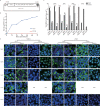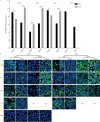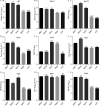Broad Host Tropism of Flaviviruses during the Entry Stage
- PMID: 36943072
- PMCID: PMC10101140
- DOI: 10.1128/spectrum.05281-22
Broad Host Tropism of Flaviviruses during the Entry Stage
Abstract
The genus Flavivirus consists of viruses with various hosts, including insect-specific flaviviruses (ISFs), mosquito-borne flaviviruses (MBFs), tick-borne flaviviruses (TBFs), and no-known vector (NKV) flaviviruses. Using the reporter viral particle (RVP) system, we found the efficient entry of ISFs into vertebrate cells, MBFs into tick cells, as well as NKVs and TBFs into mosquito cells with similar entry characteristics. By construction of reverse genetics, we found that Yokose virus (YOKV), an NKV, could enter and replicate in mosquito cells but failed to produce infectious particles. The complete removal of the glycosylation modification on the envelope proteins of flaviviruses had no obvious effect on the entry of all MBFs and TBFs. Our results demonstrate an entry-independent host-tropism mechanism and provide a new insight into the evolution of flaviviruses. IMPORTANCE Vector-borne flaviviruses, such as Zika virus, have extremely broad host and cell tropism, even though no critical entry receptors have yet been identified. Using an RVP system, we found the efficient entry of ISFs, MBFs, TBFs, and NKVs into their nonhost cells with similar characteristics. However, glycan-binding proteins cannot serve as universal entry receptors. Our results demonstrate an entry-independent host-tropism mechanism and give a new insight into the cross-species evolution of flaviviruses.
Keywords: Zika virus; entry independent; flaviviruses; host tropism.
Conflict of interest statement
The authors declare no conflict of interest.
Figures







Similar articles
-
The host range restriction of bat-associated no-known-vector flaviviruses occurs post-entry.J Gen Virol. 2021 Sep;102(9):001647. doi: 10.1099/jgv.0.001647. J Gen Virol. 2021. PMID: 34486974 Free PMC article.
-
Replication is the key barrier during the dual-host adaptation of mosquito-borne flaviviruses.Proc Natl Acad Sci U S A. 2022 Mar 22;119(12):e2110491119. doi: 10.1073/pnas.2110491119. Epub 2022 Mar 16. Proc Natl Acad Sci U S A. 2022. PMID: 35294288 Free PMC article.
-
Antigenic Characterization of New Lineage II Insect-Specific Flaviviruses in Australian Mosquitoes and Identification of Host Restriction Factors.mSphere. 2020 Jun 17;5(3):e00095-20. doi: 10.1128/mSphere.00095-20. mSphere. 2020. PMID: 32554715 Free PMC article.
-
Lipids and flaviviruses, present and future perspectives for the control of dengue, Zika, and West Nile viruses.Prog Lipid Res. 2016 Oct;64:123-137. doi: 10.1016/j.plipres.2016.09.005. Epub 2016 Oct 1. Prog Lipid Res. 2016. PMID: 27702593 Review.
-
Flavivirus Receptors: Diversity, Identity, and Cell Entry.Front Immunol. 2018 Sep 26;9:2180. doi: 10.3389/fimmu.2018.02180. eCollection 2018. Front Immunol. 2018. PMID: 30319635 Free PMC article. Review.
Cited by
-
Evolution of Zika virus in Rag1-deficient mice selects for unique envelope glycosylation motif mutants that show enhanced replication fitness.Virus Evol. 2025 Apr 11;11(1):veaf021. doi: 10.1093/ve/veaf021. eCollection 2025. Virus Evol. 2025. PMID: 40291117 Free PMC article.
-
Unleashing Nature's Allies: Comparing the Vertical Transmission Dynamics of Insect-Specific and Vertebrate-Infecting Flaviviruses in Mosquitoes.Viruses. 2024 Sep 23;16(9):1499. doi: 10.3390/v16091499. Viruses. 2024. PMID: 39339975 Free PMC article. Review.
-
Antiviral Defence Mechanisms during Early Mammalian Development.Viruses. 2024 Jan 24;16(2):173. doi: 10.3390/v16020173. Viruses. 2024. PMID: 38399949 Free PMC article. Review.
-
Development of ENTV reverse genetics system and phenotypic evaluation of rescued virus reveals host-specific replication patterns in mosquitoes.bioRxiv [Preprint]. 2025 Jul 29:2025.07.29.667424. doi: 10.1101/2025.07.29.667424. bioRxiv. 2025. PMID: 40766458 Free PMC article. Preprint.
References
-
- Guzman H, Contreras-Gutierrez MA, Travassos da Rosa APA, Nunes MRT, Cardoso JF, Popov VL, Young KI, Savit C, Wood TG, Widen SG, Watts DM, Hanley KA, Perera D, Fish D, Vasilakis N, Tesh RB. 2018. Characterization of three new insect-specific flaviviruses: their relationship to the mosquito-borne flavivirus pathogens. Am J Trop Med Hyg 98:410–419. doi:10.4269/ajtmh.17-0350. - DOI - PMC - PubMed
-
- Lindenbach BD, Thiel H-J, Rice CM. 2007. Flaviviruses: the viruses and their replication, p 1101–1152. In Knipe DM, Howley PM (ed), Fields' virologv, 5th ed. Lippincott, Williams and Wilkins, Philadelphia, PA.
LinkOut - more resources
Full Text Sources

